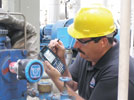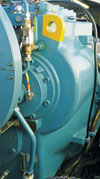

The oldest vibration sensor known to man was a seismograph invented by Chinese astronomer Chang Heng in the second century AD. This device responded to distant disturbances by depositing a bronze ball from the mouth of one of eight dragons placed at intervals around a large urn, thus indicating the direction of a distant earthquake and enabling the government to send assistance to the affected area.
Methods may have changed, but the need for vibration sensing has not diminished. As machinery has become more complex and greater productivity is demanded from each mechanical system, there has been a corresponding growth in the need for sophisticated vibration sensors that can maximise the performance of engineering processes. Today’s designers have not only succeeded in providing devices of exceptional accuracy and reliability, but also in packaging that functionality in a variety of resilient enclosures to enable its use in a wide range of applications.
The efficiency of vibration sensors has driven demand in a number of ways: as well as offering enhanced efficiency and increased performance, these devices also enable operators to satisfy the evermore robust regulations imposed regarding health and safety. These have made the use of sensors in non-safe areas a prime requisite, and, as a result, vibration sensors have become an increasingly essential fixture in modern engineering.
Choosing the best option
With so many sensors in daily operation within modern engineering systems (in the paper industry, for example, there may be 500 to 600 sensors on each machine, primarily to monitor the vibration levels on the roller bearings) maintaining high standards has become a priority, which is why training in the use of condition monitoring components such as vibration sensors is now provided by organisations such as BINDT (British Institute of Non-Destructive Testing). This is important because, despite the fact that a vibration sensor offers high levels of accuracy and reliability, the component is only as good as its installer. For example, when mounting a sensor there may be a choice between drilling, tapping or gluing, so engineers need to understand and consider how these methods may affect the warranties on their equipment.
To install and use vibration sensors to their fullest potential, engineers first need to understand how they operate. Vibration sensors, which measure a quantity of acceleration and are therefore a type of accelerometer, typically contain a piezoelectric crystal element bonded to a mass. When the accelerometer is subject to a force, the mass compresses the crystal causing it to produce an electrical signal proportional to the level of force applied. The signal is then amplified and conditioned to create an output signal suitable for use by higher level data acquisition or control systems. Outputs from accelerometers mounted in key locations can either be read periodically using sophisticated hand-held data collectors, for immediate analysis and subsequent downloading to a PC, or routed to a centralised system for continuous monitoring.
Categorisation and specification
Accelerometers can be divided into two categories: AC and 4-20mA. Although both operate under the same principle there are subtle differences between the two that engineers need to be aware of when specifying systems. AC accelerometers are typically used with a data collector for monitoring the condition of higher value assets such as wind turbines, while 4-20 mA devices are used with a PLC to measure lower value assets such as fans and pumps. Both are capable of detecting imbalance, bearing condition and misalignment, but AC accelerometers can also identify cavitation, looseness, gear defects and belt problems. AC accelerometers offer a wider frequency and dynamic range and are compatible with commercially available monitoring systems, while 4-20 mA devices offer a cost-effective alternative when AC components are not required. Market leaders such as Hansford Sensors offer a variety of accelerometers in both categories that can operate over a wide temperature range, measuring both high and low frequencies and packaged in stainless steel housings that can prevent the ingress of moisture, dust, oils and other contaminants.
The resistance to contamination offered by today’s accelerometers is vital in sectors where excessive vibration can cause anything from inflated energy consumption to catastrophic failure. Vibration monitoring offers an early warning, enabling engineers to take action before any substantial damage is caused. When machinery such as fans and motors run out of alignment, the resulting vibration leads to excessive wear and premature failure of parts. Gaining access to motors and fan units can be difficult and time consuming and without a strong condition monitoring regime engineers typically find themselves reacting to problems as they manifest themselves.

Data capture and analysis
By using a network of accelerometers positioned on machinery, a dedicated condition monitoring system to improve operational efficiency can prevent problems before they occur.
Once data has been gathered it must be analysed and interpreted. In some sectors, the most efficient means of doing this is to relay outputs from the accelerometers to a control room terminal that runs monitoring, analysis and reporting software for real-time display of all key operating parameters. For example, SKF @ptitude software does just that and has achieved measurable results by allowing engineers to identify wear in key components long before it becomes a potential problem, enabling the planning of essential maintenance when production demands are low. In addition, the SKF Microlog family of portable vibration monitoring and data collection instruments enables easy onsite data collection and analysis processes.
To specify vibration monitoring equipment correctly, engineers need to ask the right questions from the outset: consultation with a market leader experienced in a wide range of sectors swiftly enables the right decisions to be made. From the initial question: ‘what is the vibration level and frequency range to be measured?’ engineers need to consider environmental conditions such as temperature, humidity, and whether there are any corrosive chemicals present. A series of further considerations follow because today’s vibrations sensors are available for a wide range of sectors, including offshore, petrochemical, utilities, paper, marine, metals, water and waste treatment, aerospace, pharmaceutical, automotive and beyond.
Technology has come a long way since Chang Heng’s ingenious seismograph and vibrations far smaller than earthquakes can now be detected reliably using accelerometers. Chang applied an earthly, scientific attitude to the challenges presented by earthquakes, contradicting the orthodox opinion that viewed such disturbances as representations of the displeasure of the gods. While his elders awaited their fate Chang preferred to take a more hands-on approach, today, rather than crossing the fingers and hoping for the best, engineers can follow this example by protecting plant and productivity using vibration monitoring techniques.
| Tel: | +27 11 791 6000 |
| Email: | [email protected] |
| www: | www.tempcon.co.za |
| Articles: | More information and articles about Temperature Controls |

© Technews Publishing (Pty) Ltd | All Rights Reserved